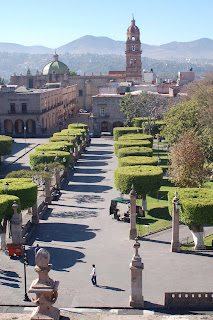We had one unscheduled stop to fix a flat tire on the bus. Lots of entertainment on board with videos, bingo, bar, and great scenery. We arrived at our hotel in Morelia at 8 PM that night.
There are many farms in this state and they look to have a lot of rocky soil, since most of the fences are made up of rocks stacked together with no mortar. It would seem that the rocky soil may have something to do with the number of volcanoes in the area. Some of the crops are sugar cane, grain crops, produce, fruit, corn, and blue agave which is used in the production of tequila.

It is also a state of contrasts were you can see a farmer working the land with a ox or horse right beside a gravel operation that is using huge new bulldozers and loaders out of the window on the bus as we travelled down a four lane toll highway .
Our Hotel:
The Hotel Cathedral is an old colonial style building across the street from the main city plaza called Plaza de Armas and just down the street from the main cathedral which was built from 1640-1744. Our room was on the second floor with a large patio looking out on the plaza and downtown of the city. Our room was great except for the church bells ringing at all hours of the day and night. We think it must have been something to do with Lent.


Morelia:
Is located in the State of Michoacán and was founded in 1541 and was declared a UNESCO World Heritage site in 1991. Originally called Nueva Espana it was renamed to honour local hero Jose Maria Morelos Y Pavon who was one of the leaders in the fight to gain Mexico independence from Spain. The current population of the city is about 1.3 million and is located 6399 ft above sea level.
Forty nine buildings have been designated as heritage buildings designed in the baroque stlye. they are all very ornate with arches, status and muriels along with neoclassic mixed in.
Most were within walking distance of our hotel and as many as 12 universities make their homes in Morelia. Parts of the aqua duct build in 1789 to supply water to the city still remain in place; however they are no longer used.
The narrow streets in the City required all the skills our bus drivers had.
On the day we were leaving the teachers were holding a protest, and had 5 or 6 streets blocked off and since there was also an event planned for the street in front of our hotel it was closed to bus traffic. The closest the bus could get was two blocks so we all preceded to hull our luggage down the street.
Tzintzuntzan:
We arrived in this small town just to catch a parade celebrating Flag Day. Mexicans have many holidays and celebrations.
Right along side the highway as you enter the down there is a very nice cemetery with many impressive monuments.
There are some ruined pyramids here that were constructed by the Tarascan natives. These pyramids are round instead of square as the others in Mexico.
A lot of the materials from these sites were removed in the 16th century to build some the churches and walls surrounding the churches for the Franciscan Monks.
The church court yard also contains some very large old olive trees.
Patzcuaro:
This colonial city of about 50,000 people was once the capital of the Tarasco people, in the years around 1300. The city features many buildings from the 17th century. The production of handicrafts is also an important source of income for the residents, many who are Tarasco Indians.

The Catholic Church is a big part of most cities in this state. A large church built in the 16th century is located near the city center. The Casa De Los Once Patios (House of the 11 Courtyards) is a rambling building that was built as a convent in the 1740s. It is now used to house various merchants selling handicrafts.
Lago de Patzcuaro:
This fairly large shallow lake features an island called Isla Janitzio is a popular tourist area. To reach the island one takes a ferry that can carry about 40 or 50 passengers. Do not expect any safety announcements about life jackets etc, but be prepared to be entertained by the Mexican two man band. The boat we were on was powered by a Chevy gas engine, 3 speed manual transmission, clutch and gas pedal.
Isla Janitzio.

Is completely covered by homes and shops. We are not sure what the residents do to make a living but a lot of them sell handicrafts to the many tourists who come to visit the 40 meter high statue to Mexican revolution hero Jose MariaMoelos y Pavon.


Getting to the statue requires a very steep climb up thru the market area. Aprox 300 steps
Once you reach the top of the island you can then go inside the statue that has a circular stairway to the top of the statue. At the top there is just enough room to get you head and shoulders out to take a look at the great view of the surrounding county. Unfortunately no pictures are allowed inside the statue of the many murals that cover the inside wall, but Debbie did manage to sneak a couple.

Santa Clara del Cobre:
Is a small town famous for it copper works. We were treated to a display of how copper is turned into merchandise.
























































